
Detecting vitiligo and recognizing its signs and symptoms is crucial for early diagnosis and appropriate treatment. Vitiligo is a chronic skin condition that causes pale white patches to appear on the skin due to a lack of melanin, the skin pigment. While it can affect any part of the body, it is most commonly found on the face, neck, hands, and skin creases, and may also begin in the lips, fingertips, and genital areas.
Vitiligo is not life-threatening or contagious, and though it is classified as an autoimmune disorder, it is seldom associated with issues in other endocrine organs like the thyroid or adrenal glands.
Signs and Symptoms of Vitiligo:
- Loss of skin color in patches, typically noticeable first on the face, hands, arms, legs, and feet.
- Premature graying of body hair, including eyelashes, eyebrows, and facial hair if the affected areas are involved.
- It is mostly asymptomatic, with no itching or pain experienced.
- Possible association with thyroid and adrenal gland problems.
Detecting Vitiligo:
A dermatologist can diagnose vitiligo through a thorough skin examination. To rule out other skin conditions, the doctor will look for symptoms associated with them, such as other hypopigmentary disorders like common eczemas or healing psoriasis lesions. Dark-skinned individuals often have easily identifiable patches, but a Wood lamp emitting ultraviolet light may be used for lighter-skinned individuals to distinguish affected from unaffected skin.
The appearance of lightened patches and the patient’s medical history are usually sufficient for diagnosing vitiligo. However, doctors may recommend additional tests for confirmation, such as a skin biopsy to check for the presence of melanocytes (cells responsible for skin pigmentation) and to exclude hypopigmented cutaneous T-cell lymphoma, a type of skin cancer. A blood test may be advised to determine if vitiligo is linked to an underlying autoimmune disease, like anemia or type 1 diabetes, as vitiligo has been associated with other autoimmune diseases and endocrine disorders.
Treatment for Vitiligo:
While there is currently no cure for vitiligo, various treatment options aim to halt or slow down the discoloration process and restore some skin color. Treatment goals include achieving an even skin tone through repigmentation (restoring color) or depigmentation (removing remaining color). Common treatments for vitiligo include camouflage therapy, repigmentation therapy, light therapy, and surgery.
It’s important to seek medical advice promptly if vitiligo is suspected, as early intervention can lead to better management and improved outcomes. Left untreated, vitiligo patches may continue to develop and, in some cases, widespread pigment loss may occur. However, it’s essential to note that rare instances of spontaneous repigmentation have been reported.
